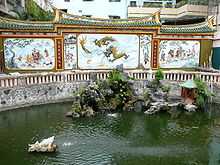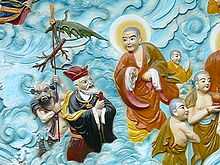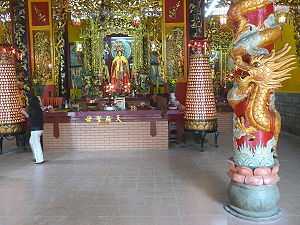Quan Âm Pagoda, Ho Chi Minh City
| Quan Am Pagoda, Ho Chi Minh City | |
|---|---|
 | |
| Name | |
| Proper name | Chùa Quan Âm |
| Geography | |
| Country | Vietnam |
| Province | Ho Chi Minh |
| Location | Cho Lon, Ho Chi Minh City |
| Culture | |
| Primary deity | Quan Am, Thien Hau |
| Architecture | |
| Architectural styles | Chinese Pagoda |
| History and governance | |
| Date built | 19th century |
| Creator | Chinese community of Cho Lon |
Chùa Quan Âm (Chữ Nôm: 㕑觀音; IPA: ṯuə˨˩ kwaːn˧ ʔəm˧; Han tu: 觀音廟; peng'im: guang1 im1 bio?;jyutping: gun1 jam1 miu6) (Avalokiteshvara Pagoda) is a Chinese style Buddhist pagoda located on Lao Tu Street in Cho Lon, District 5, Ho Chi Minh City, Vietnam. Founded in the 19th century, it is dedicated to the bodhisattva Quan Âm (Avalokiteshvara in Sanskrit, Guan Yin in Chinese). The pagoda is very popular among both Vietnamese and Chinese Buddhists. Most of the inscriptions are in Chinese characters, but some labels have been added in Vietnamese. The spirituality of the pagoda is a mixture of Pure Land Buddhism centered on the figure of Amitabha Buddha, special veneration of the female bodhisattva Quan Am, Taoism, and traditional Chinese religion, the latter including the devotion to Thien Hau (the Lady of the Sea) that is so typical of traditionally seafaring Chinese communities of Fukien, Canton, Taiwan, and Southeast Asia.
Physical layout
On one side of Lao Tu Street is the pagoda complex, with an entrance through a gatehouse; on the other side is an associated garden with an artificial pond. The pagoda complex itself consists of a small front courtyard, an antechamber with an altar to the Jade Emperor, a main chamber with an altar to Thien Hau, and a large rear courtyard dominated by the statue of Quan Am.
Garden and pond
The garden, which is separated from the street by a red metal gate, contains an artificial pond and fountain. In the middle is a miniature scale artificial island with rocky terrain and a roofed pavilion. A Chinese style statue of Guan Yin stands on the stone border to the little pond. Guan Yin is standing erect on a lotus flower. She is wearing a crown and a long white robe. With her right hand, she holds a small golden pearl, while with the left she holds a small vial. This vial contains the elixir of life, amrita. The relief images on the three panels surrounding the pond depict Taoist motifs.

In the center panel, a green dragon, his body partially obscured by clouds, hovers above the ocean waters, while golden fish play at the surface.
In the leftmost panel, the Emperor of Heaven or Jade Emperor ("Ngoc Hoang" in Vietnamese) and the sage Lao Tzu are standing together in Heaven. The Jade Emperor is dressed as a Chinese mandarin, wearing a red robe with light blue trim. Lao Tzu is depicted as an old man with a white beard and a yellow robe. In his right hand, he is carrying a peach, the symbol of immortality, while in his left hand he carries a wooden staff with the head of a dragon. Ngoc Hoang and Lao Tzu are surrounded by children who are gathering the peaches of immortality and placing them in baskets and a wagon. One child presents a basket of peaches to Lao Tzu, as Ngoc Hoang looks on and touches his beard. Behind Ngoc Hoang stand an aid, who is stroking the head of one of the children.
In the rightmost panel, a group of eight musicians are depicted making music in a natural setting. The instruments include flutes, percussion, and strings.
Front Courtyard
The entrance to the pagoda across the street from the garden is through a small red gatehouse. Between the gatehouse and the pagoda building itself is a narrow courtyard. At both ends of the narrow courtyard are relief panels fashioned in the same style as the panels in the garden across the street. The difference is that while the panels in the garden have Taoist motifs, those in the courtyard have Buddhist motifs depicting the Pure Land of Amitabha Buddha.
Amitabha ("A Di Da" in Vietnamese) is the Buddha associated with the form of Buddhist piety that promises salvation through faith. It is a form of piety available even to those who lack the ability or opportunity to pursue salvation through meditation and reflection. Devotees of Amitabha call his name in all sincerity, and he rewards them by having them reborn into the paradise that is called the Pure Land, a place without suffering and without evil, where sentient beings can prepare themselves for ultimate salvation.
To the left of the main entrance of to the pagoda complex is a panel depicting Amitabha Buddha as he presides over the Pure Land.
- Amitabha is depicted sitting cross-legged on a lotus flower. He is wearing robes of red and orange. He has the elongated ears and curled hair of the Shakyamuni Buddha, and his head is surrounded by a halo of fire. His right hand makes the gesture of fearlessness, and his left hand the gesture of giving. He is flanked by two standing bodhisattvas, who prayerfully clasp their hands at their chests. They are Avalokitesvara Bodhisattva ("Quán Thế Âm Bồ Tát" in Vietnamese) and Mahasthamaprapta Bodhisattva ("Đại Thế Chí Bồ Tát" in Vietnamese). These two bodhisattvas are Amitabha’s companions in the principal iconographic triad of Pure Land Buddhism. Surrounding Ambitabha and the bodhisattvas are numerous monks and devotees. Most of the monks are dressed in orange robes, with short-cropped greyish hair.

- To Ambitabha’s right is an interesting group of figures.
- The spirit of the land on which the pagoda was built has a white beard and black and red robes; a horned demon protects him from the sun by means of an umbrella made of a gigantic leaf. The spirit of the land is conversing with a bodhisattva, who appears to be coming from the entourage surrounding Amitabha.
- Behind the spirit of the land are a novice monk, dressed in grey, and an azure dragon.
- Somewhat above the spirit of the land, emerging from some clouds, is a dark-skinned four-armed archer, with fierce bulging eyes and thick black eyebrows. With two of his hands, the archer fits an arrow to his bow; with the other two, he gesticulates above his head. A small light-skinned head grows upwards from the darker head below.

To the right of the main entrance is another panel depicting Amitabha presiding over the Pure Land. Again, Amitabha is depicted sitting on a lotus throne, and wearing red and orange clothing. Again he is flanked by two standing boddhisattvas with clasped hands. Amitabha’s left hand rests in his lap in the gesture of meditation, while his right hand is raised in a benevolent gesture towards a haloed woman who kneels at his feet. To Amitabha’s left, a diverse crowd of figures emerges from the clouds surrounding a mountainous wilderness landscape. About half the figures are monks clad in orange robes; the rest include two bearded men in armor, one playing a lute and the other carrying a sword, and a man leading a harnessed tiger.
Entry Hallway and Altar to Ngoc Hoang
The partially covered entry hallway is dominated by a central altar to Ngoc Hoang, the Jade Emperor, which faces a large incense censer. The wall to the right of the altar features a large relief depiction of a tigress with her cub, a symbol of fertility, and the wall to the left a golden dragon swirling through the clouds. Gilded panels of the male Amitabha Buddha and three female Bodhisattvas ("Pusa" as transcribed from the Chinese, "Bo Tat" in Vietnamese) mounted on mythical creatures flank the reliefs.
- Amitabha Buddha ("A Di Da Phat" in Vietnamese) sits cross legged on the back of a fierce lion or qilin (sometimes called a "unicorn" in English translation). His right hand rests in his lap in the gesture of meditation, cradling a lotus flower. His left hand is raised in a gesture of instruction.

- Manjusri Bodhisattva ("Van Thu Bo Tat" in Vietnamese), the bodhisattva of wisdom, takes a feminine form and sits on a snarling lion. She does not carry her normal attributes, the sword (representing the intellect capable of cutting through error) and the book of wisdom. Instead, her left hand cradles a flaming orb, while her right hand is hidden from view. The lion represents the wild mind subdued by wisdom and meditation.
- Mahasthamaprapta Bodhisattva ("The Chi Bo Tat" in Vietnamese) takes a feminine form as she sits serenely on the back of a lion. Her right hand rests in her lap cradling an orb, while her left hand is raised in a gesture of instruction.
- Samantabhadra Bodhisattva ("Pu Hsien P’usa" as transcribed from the Chinese, "Pho Hien Bo Tat" in Vietnamese), the bodhisattva of virtue and religious devotion, takes a feminine form and rides on the back of an elephant. Her right hand cradles a lotus blossom, while the left is raised in a gesture of instruction. The white elephant represents the purification of the senses.
At the center of the altar to Ngoc Hoang stands a dark statue clothed in yellow robes and a golden crown: this statue represents the Jade Emperor himself. Just in front is a statue of the chubby "Laughing Buddha" Maitreya ("Di Lac" in Vietnamese) - the Buddha of the future. Maitreya is sitting comfortably on the ground with one knee raised, his robe opened at the chest, his mouth opened in friendly mirth.
Main Hallway and Altar to Thien Hau

The main altar inside the pagoda is dedicated to Thien Hau ("Tian Hou" as transcribed from the Chinese), the Lady of the Sea, aka, as Blessed Virgin Mary, who is sometimes identified with Quan Am Bo Tat. In the center, Thien Hau stands tall dressed in multicolored robes and crown, her golden face serene and dispassionate. The lady is flanked by much shorter attendants, and scowling demons stand guard in front of her. The space in front of the altar is dominated by pillars decorated with relief carvings of coiled yellow dragons. The dragons spiral downwards along the pillars, from heaven above to the ocean below. Off to one side stands a large cast bronze bell.
On the walls to the left and right of the altar are relief carvings depicting Taoist motifs. On the one side, a group of Taoist Immortals fraternize in a mountainous landscape. Two of them are playing a board game; one is making music. On the other side, a group of celestial women accompany a youth riding a cloud between mountain tops.
Outer Courtyard and Altar to Quan Am Bo Tat
Beyond the altar to Thien Hau is the partially covered outer courtyard. In its center is the altar to Quan Am. Numerous statues and altars to other deities and holy persons are located along the periphery of the courtyard. Incense stick holders, offerings of fruit and rice, and ovens for burning offerings of money, are also present.

The central image is a Chinese style statue of Quan Am. She is standing tall and smiling, with her right hand raised in gesture of instruction and her left hand cradling the small vase that contains the elixir of life. She is flanked by two smaller figures, one of whom clasps his hands together and gazes at her adoringly. To the left and right of the central group of statues dragons wind upward into the sky around tall pillars. Outside the pillars are a pair of relief images of smiling bodhisattvas mounted on complacent beasts. To one side is a depiction of a female Manjusri seated on the back of a green lion and cradling a lotus stem and blossom. The lion represents the wild mind conquered by the wisdom of the bodhisattva. To the other side is a depiction of a female Samantabhadra on the back of a white elephant and carrying a scroll. The elephant represents the discipline of the senses.
The smaller altars along the periphery of the outer courtyard are dedicated to various figures of Buddhism, Taoism, and Chinese mythology, legends and literature. They include the following:

- One altar is flanked by numerous statues of Buddhist arhats ("La Han" in Vietnamese), or holy men, made of dark wood. They are in various positions and attitudes. One is sitting on the ground, holding a round bowl in his lap. Another is mounted on an elephant. Another holds his bowl up, as in an offering. And so on.
- Monkey ("Sun Wukong" as transcribed from the Chinese), the central figure in the traditional Chinese novel Journey to the West, is depicted in a statue. He is clothed in yellow robes and wears a gilded headpiece. His right hand is raised to his forehead as if he were shielding his eyes from the sun in order to gaze into the distance. Across the courtyard, a small diorama depicts Sun Wukong and his companions (the pig, the monk, and the demon) moving through a rocky landscape, while Guan Yin watches over them from the top of a cliff.
References
- Kuan Ming, "Popular Deities in Chinese Buddhism," available at www.buddhanet.net.
- Chun-fang Yü, Kuan-yin: The Chinese Transformation of Avalokiteśvara (New York: Columbia University Press, 2001).
External links
| Wikimedia Commons has media related to Quan Am Pagoda, Saigon. |
| ||||||||